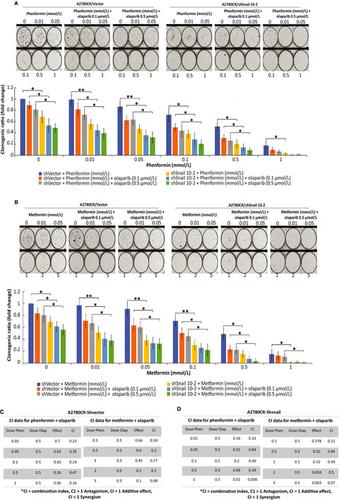当前位置:
X-MOL 学术
›
Cancer Med.
›
论文详情
Our official English website, www.x-mol.net, welcomes your feedback! (Note: you will need to create a separate account there.)
Biguanides in combination with olaparib limits tumorigenesis of drug-resistant ovarian cancer cells through inhibition of Snail.
Cancer Medicine ( IF 4 ) Pub Date : 2019-12-21 , DOI: 10.1002/cam4.2738 Qiong Wang 1, 2, 3 , Vanessa M López-Ozuna 1, 4 , Tahira Baloch 1, 5 , Joanne Bithras 1 , Oreekha Amin 1, 4 , Roy Kessous 1, 4 , Liron Kogan 1, 4 , Ido Laskov 1, 4 , Amber Yasmeen 1, 4
Cancer Medicine ( IF 4 ) Pub Date : 2019-12-21 , DOI: 10.1002/cam4.2738 Qiong Wang 1, 2, 3 , Vanessa M López-Ozuna 1, 4 , Tahira Baloch 1, 5 , Joanne Bithras 1 , Oreekha Amin 1, 4 , Roy Kessous 1, 4 , Liron Kogan 1, 4 , Ido Laskov 1, 4 , Amber Yasmeen 1, 4
Affiliation

|
Ovarian cancer is the most lethal gynecological malignancy. Currently, new chemotherapeutic strategies are required to improve patient outcome and survival. Biguanides, classic anti-diabetic drugs, have gained importance for theiri antitumor potency demonstrated by various studies. Olaparib is a PARP inhibitor approved for maintenance therapy following platinum-based chemotherapy. Furthermore, Snai1, a transcription factor that works as a master regulator of the epithelial/mesenchymal transition process (EMT) is involved in ovarian cancer resistance and progression. Here we aimed to demonstrate the possible cross talk between biguanides and Snail in response to olaparib combination therapy. In this study, we have shown that while in A2780CR cells biguanides reduced cell survival (single treatments ~20%; combined treatment ~44%) and cell migration (single treatments ~45%; biguanide-olaparib ~80%) significantly, A2780PAR exhibited superior efficacy with single (~60%) and combined treatments (~80%). Moreover, our results indicate that knock-down of Snail further enhances the attenuation of migration, inhibits EMT related-proteins (~90%) and induces a synergistic effect in biguanide-olaparib treatment. Altogether, this work suggests a novel treatment strategy against drug-resistant or recurrent ovarian cancer.
中文翻译:

双胍类药物与奥拉帕尼联合通过抑制Snail限制了耐药性卵巢癌细胞的肿瘤发生。
卵巢癌是最致命的妇科恶性肿瘤。当前,需要新的化学治疗策略来改善患者的预后和生存。双胍类药物是经典的抗糖尿病药物,已通过各种研究证明其对鸢尾类抗肿瘤药的重要性。Olaparib是一种PARP抑制剂,已批准用于铂类化学疗法后的维持治疗。此外,Snai1是一种转录因子,可作为上皮/间质转化过程(EMT)的主要调节剂,参与卵巢癌的抵抗和进展。在这里,我们旨在证明双胍类药物和Snail之间可能存在的对olaparib联合治疗的反应。在这项研究中,我们已经表明,在A2780CR细胞中,双胍类药物会降低细胞存活率(单次治疗约20%;单次治疗约20%)。联合治疗(〜44%)和细胞迁移(单个治疗〜45%;双胍-奥拉帕尼〜80%)显着,A2780PAR在单次治疗(〜60%)和联合治疗(〜80%)中表现出优异的疗效。此外,我们的结果表明,Snail的敲除进一步增强了迁移的衰减,抑制了EMT相关蛋白(〜90%),并在双胍-奥拉帕尼治疗中产生了协同作用。总而言之,这项工作提出了一种针对耐药性或复发性卵巢癌的新颖治疗策略。抑制EMT相关蛋白(约90%)并在双胍-奥拉帕尼治疗中诱导协同作用。总而言之,这项工作提出了一种针对耐药性或复发性卵巢癌的新颖治疗策略。抑制EMT相关蛋白(约90%)并在双胍-奥拉帕尼治疗中诱导协同作用。总而言之,这项工作提出了一种针对耐药性或复发性卵巢癌的新颖治疗策略。
更新日期:2019-12-21
中文翻译:

双胍类药物与奥拉帕尼联合通过抑制Snail限制了耐药性卵巢癌细胞的肿瘤发生。
卵巢癌是最致命的妇科恶性肿瘤。当前,需要新的化学治疗策略来改善患者的预后和生存。双胍类药物是经典的抗糖尿病药物,已通过各种研究证明其对鸢尾类抗肿瘤药的重要性。Olaparib是一种PARP抑制剂,已批准用于铂类化学疗法后的维持治疗。此外,Snai1是一种转录因子,可作为上皮/间质转化过程(EMT)的主要调节剂,参与卵巢癌的抵抗和进展。在这里,我们旨在证明双胍类药物和Snail之间可能存在的对olaparib联合治疗的反应。在这项研究中,我们已经表明,在A2780CR细胞中,双胍类药物会降低细胞存活率(单次治疗约20%;单次治疗约20%)。联合治疗(〜44%)和细胞迁移(单个治疗〜45%;双胍-奥拉帕尼〜80%)显着,A2780PAR在单次治疗(〜60%)和联合治疗(〜80%)中表现出优异的疗效。此外,我们的结果表明,Snail的敲除进一步增强了迁移的衰减,抑制了EMT相关蛋白(〜90%),并在双胍-奥拉帕尼治疗中产生了协同作用。总而言之,这项工作提出了一种针对耐药性或复发性卵巢癌的新颖治疗策略。抑制EMT相关蛋白(约90%)并在双胍-奥拉帕尼治疗中诱导协同作用。总而言之,这项工作提出了一种针对耐药性或复发性卵巢癌的新颖治疗策略。抑制EMT相关蛋白(约90%)并在双胍-奥拉帕尼治疗中诱导协同作用。总而言之,这项工作提出了一种针对耐药性或复发性卵巢癌的新颖治疗策略。



























 京公网安备 11010802027423号
京公网安备 11010802027423号